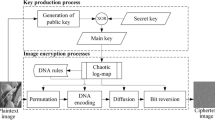Abstract
At present, watermarking techniques play an important role in protecting digital images. To date, many classical watermarking schemes have been developed to protect images based on spatial and transform domains. However, classical watermarking schemes are less resilient to many attacks. Recently, deep learning-based watermarking made a significant contribution to image content security and received attention for various popular applications. In this paper, we use convolutional neural networks (CNNs) to propose an interesting watermarking technique for digital images. Initially, latent features of cover and secret images are extracted using an encoder network and later concatenated to generate a marked image. On the receiver side, a denoising autoencoder network is used to remove noise variations from the received image and later to extract the secret mark image using a CNN. Our technique not only imperceptibly hides an image inside a cover image but also outperforms other state-of-the-art schemes in terms of visual quality and robustness according to simulation results and performance comparisons.











Similar content being viewed by others
References
Amrit P, Singh AK (2022) Survey on watermarking methods in the artificial intelligence domain and beyond. Comput Commun 188:52–65
Anand A, Singh AK, Zhou H (2023) A survey of medical image watermarking: state-of-the-art and research directions. Med Inform Process Secur: Tech Appl 14:325–360. https://doi.org/10.1049/PBHE044E_ch14
Anand A, Kumar Singh A (2022) A comprehensive study of deep learning-based covert communication. ACM Trans Multimedia Comput Commun Appl (TOMM) 18(2s):1–19
Bagheri M, Mohrekesh M, Karimi N, Samavi S, Shirani S, Khadivi P (2020) Image watermarking with region of interest determination using deep neural networks. In 2020 19th IEEE International Conference on Machine Learning and Applications (ICMLA). IEEE, pp 1067–1072
Chen J, Zhang J, Debattista K, Han J (2023) Semi-supervised unpaired medical image segmentation through task-affinity consistency. IEEE Trans Med Imaging 42(3):594–605
Deng J, Dong W, Socher R, Li LJ, Li K, Fei-Fei L (2009) Imagenet: A large-scale hierarchical image database. In 2009 IEEE conference on computer vision and pattern recognition. IEEE, pp 248–255
Ding W, Ming Y, Cao Z, Lin CT (2021) A generalized deep neural network approach for digital watermarking analysis. IEEE Trans Emerg Top Comput Intell 6(3):613–627
Fkirin A, Attiya G, El-Sayed A, Shouman MA (2022) Copyright protection of deep neural network models using digital watermarking: a comparative study. Multimedia Tools Appl 81(11):15961–15975
Ge S, Xia Z, Fei J, Sun X, Weng J (2022) A robust document image watermarking scheme using deep neural network. arXiv preprint arXiv:2202.13067
Islam M, Roy A, Laskar RH (2018) Neural network based robust image watermarking technique in LWT domain. J Intell Fuzzy Syst 34(3):1691–1700
Kaggle Cats vs Dogs dataset. Available at https://www.kaggle.com/c/dogs-vs-cats. Accessed 10 Jan 2023
Krizhevsky A, Hinton G (2009) Learning multiple layers of features from tiny images, Technical Report TR-2009, University of Toronto, Toronto
Kumar C, Singh AK, Kumar P (2018) A recent survey on image watermarking techniques and its application in e-governance. Multimedia Tools Appl 77:3597–3622
Liu Z, Luo P, Wang X, Tang X (2018) Large-scale celebfaces attributes (celeba) dataset. Retrieved August, 15(2018):11
Liu Y, Zhang D, Zhang Q, Han J (2022) Part-object relational visual saliency. IEEE Trans Pattern Anal Mach Intell 44(7):3688–3704
Mahapatra D, Amrit P, Singh OP, Singh AK, Agrawal AK (2022) Autoencoder convolutional neural network-based embedding and extraction model for image watermarking. J Electron Imaging 32(2):021604
Mikołajczyk A, Grochowski M (2018) Data augmentation for improving deep learning in image classification problem. 2018 international interdisciplinary PhD workshop (IIPhDW). IEEE, pp 117–122
Mohanty SP, Sengupta A, Guturu P, Kougianos E (2017) Everything You want to know about Watermarking: from paper marks to hardware protection. IEEE Consum Electron Mag 6(3):83–91
Panchikkil S, Vegesana SP, Manikandan VM, Donta PK, Maddikunta PKR, Gadekallu TR (2023) An ensemble learning approach for reversible data hiding in encrypted images with fibonacci transform. Electronics 12(2):450
Rahim R, Nadeem S (2018) End-to-end trained CNN encoder-decoder networks for image steganography. In Proceedings of the European Conference on Computer Vision (ECCV) Workshops, pp 0–0
Singh HK, Singh AK (2023) Comprehensive review of watermarking techniques in deep-learning environments. J Electron Imaging 32(3):1–23
Wang X, Ma D, Hu K, Hu J, Du L (2021) Mapping based residual convolution neural network for non-embedding and blind image watermarking. J Inform Secur Appl 59:102820
Wei Q, Wang H, Zhang G (2020) A robust image watermarking approach using cycle variational autoencoder. Secur Commun Netw 2020:1–9
Zheng, W., Mo, S., Jin, X., Qu, Y., Deng, F., Shuai, J., … Long, S. (2018). Robust and high-capacity watermarking for image based on DWT-SVD and CNN. In: 2018 13th IEEE Conference on Industrial Electronics and Applications (ICIEA). IEEE, pp 1233–1237
Zhong X, Huang PC, Mastorakis S, Shih FY (2020) An automated and robust image watermarking scheme based on deep neural networks. IEEE Trans Multimedia 23:1951–1961
Acknowledgements
This research was supported by project no. DLRL/21CR0003/ SWCC&ENT/GN/LP dt. 29 August, 2020, DLRL, Hyderabad, India.
Author information
Authors and Affiliations
Corresponding author
Ethics declarations
Conflict of interest
The authors of this manuscript declare no conflicts of interest.
Additional information
Publisher’s note
Springer Nature remains neutral with regard to jurisdictional claims in published maps and institutional affiliations.
Rights and permissions
Springer Nature or its licensor (e.g. a society or other partner) holds exclusive rights to this article under a publishing agreement with the author(s) or other rightsholder(s); author self-archiving of the accepted manuscript version of this article is solely governed by the terms of such publishing agreement and applicable law.
About this article
Cite this article
Singh, H.K., Singh, A.K. Digital image watermarking using deep learning. Multimed Tools Appl 83, 2979–2994 (2024). https://doi.org/10.1007/s11042-023-15750-x
Received:
Revised:
Accepted:
Published:
Issue Date:
DOI: https://doi.org/10.1007/s11042-023-15750-x




